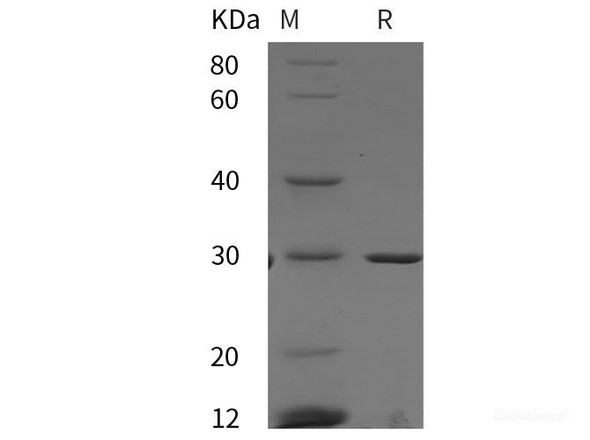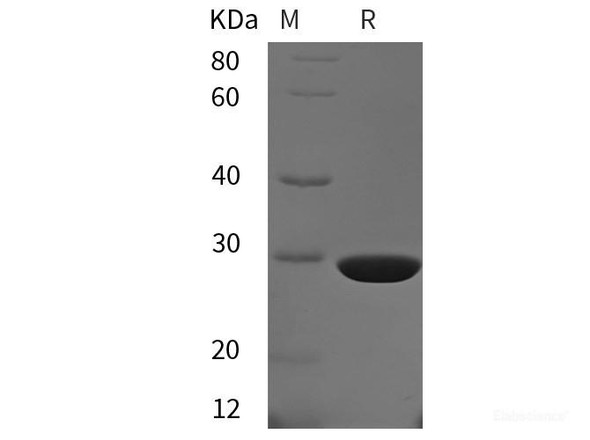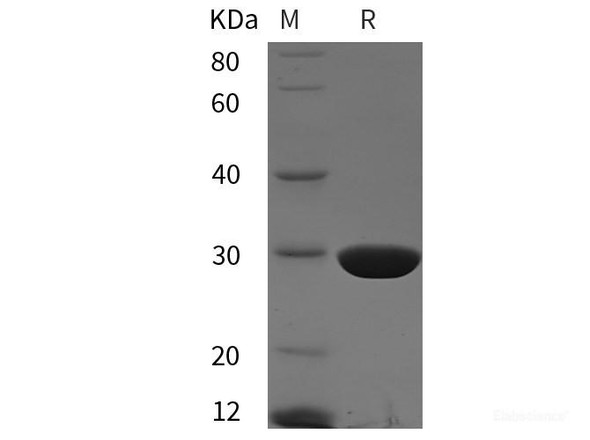Description
| Product Name: | Human GSTA1 Recombinant Protein |
| Product Code: | RPPB1756 |
| Size: | 50µg |
| Species: | Human |
| Target: | GSTA1 |
| Synonyms: | GST2, GSTA1-1, GTH1, GSTA-1, GSTAI, GSTA-I, EC 2.5.1.18, Glutathione S-transferase A1, GST HA subunit 1, GST-epsilon, GST class-alpha member 1, GSTA1, MGC131939. |
| Source: | Escherichia Coli |
| Physical Appearance: | Sterile Filtered colorless solution. |
| Formulation: | The GSTA1 solution (1mg/ml) contains 20mM Tris-HCl buffer (pH 8.0), 1mM DTT and 10% glycerol. |
| Stability: | Store at 4°C if entire vial will be used within 2-4 weeks. Store, frozen at -20°C for longer periods of time. For long term storage it is recommended to add a carrier protein (0.1% HSA or BSA).Avoid multiple freeze-thaw cycles. |
| Purity: | Greater than 90.0% as determined by SDS-PAGE. |
| Amino Acid Sequence: | MAEKPKLHYF NARGRMESTR WLLAAAGVEF EEKFIKSAED LDKLRNDGYL MFQQVPMVEI DGMKLVQTRA ILNYIASKYN LYGKDIKERA LIDMYIEGIA DLGEMILLLP VCPPEEKDAK LALIKEKIKN RYFPAFEKVL KSHGQDYLVG NKLSRADIHL VELLYYVEEL DSSLISSFPL LKALKTRISN LPTVKKFLQP GSPRKPPMDE KSLEEARKIF RF |
| Biological Activity: | Specific activity is 35,000 pmol/min/ug, and is defined as the amount of enzyme that conjugate 1.0 u mole of 1-chloro-2,4-dinitrobenzene (CDNB) with reduced glutathione per minute at pH 6.5 at 25�C. |
Membrane-bound & Cytosolic forms of GST are encoded by 2 separate supergene families. These enzymes function in the detoxification of electrophilic compounds, including carcinogens, therapeutic drugs, environmental toxins and products of oxidative stress, by conjugation with glutathione. There are 8 different classes of soluble cytoplasmic mammalian GST: alpha, kappa, mu, omega, pi, sigma, theta and zeta. The GSTA1 is found in a cluster mapped to chromosome 6, and is highly expressed in the liver. GSTA1 protects the cells from reactive oxygen species.
GSTA1 Human Recombinant produced in E.Coli is a single, non-glycosylated, polypeptide chain containing 222 amino acids (1-222 a.a.) and having a molecular mass of 25.6 kDa.The GSTA1 is purified by proprietary chromatographic techniques.
| UniProt Protein Function: | GSTA1: Conjugation of reduced glutathione to a wide number of exogenous and endogenous hydrophobic electrophiles. Belongs to the GST superfamily. Alpha family. |
| UniProt Protein Details: | Protein type:Xenobiotic Metabolism - metabolism by cytochrome P450; Other Amino Acids Metabolism - glutathione; Xenobiotic Metabolism - drug metabolism - cytochrome P450; EC 2.5.1.18; Transferase Chromosomal Location of Human Ortholog: 6p12.1 Cellular Component: cytosol Molecular Function:glutathione transferase activity Biological Process: glutathione metabolic process; epithelial cell differentiation; metabolic process; xenobiotic metabolic process |
| NCBI Summary: | Cytosolic and membrane-bound forms of glutathione S-transferase are encoded by two distinct supergene families. These enzymes function in the detoxification of electrophilic compounds, including carcinogens, therapeutic drugs, environmental toxins and products of oxidative stress, by conjugation with glutathione. The genes encoding these enzymes are known to be highly polymorphic. These genetic variations can change an individual's susceptibility to carcinogens and toxins as well as affect the toxicity and efficacy of some drugs. At present, eight distinct classes of the soluble cytoplasmic mammalian glutathione S-transferases have been identified: alpha, kappa, mu, omega, pi, sigma, theta and zeta. This gene encodes a glutathione S-tranferase belonging to the alpha class. The alpha class genes, located in a cluster mapped to chromosome 6, are the most abundantly expressed glutathione S-transferases in liver. In addition to metabolizing bilirubin and certain anti-cancer drugs in the liver, the alpha class of these enzymes exhibit glutathione peroxidase activity thereby protecting the cells from reactive oxygen species and the products of peroxidation. [provided by RefSeq, Jul 2008] |
| UniProt Code: | P08263 |
| NCBI GenInfo Identifier: | 121730 |
| NCBI Gene ID: | 2938 |
| NCBI Accession: | P08263.3 |
| UniProt Secondary Accession: | P08263,Q14750, Q5GHF8, Q5SZC1, |
| UniProt Related Accession: | P08263 |
| Molecular Weight: | 222 |
| NCBI Full Name: | Glutathione S-transferase A1 |
| NCBI Synonym Full Names: | glutathione S-transferase alpha 1 |
| NCBI Official Symbol: | GSTA1�� |
| NCBI Official Synonym Symbols: | GST2; GTH1; GSTA1-1�� |
| NCBI Protein Information: | glutathione S-transferase A1; GST-epsilon; GST HA subunit 1; GST, class alpha, 1; GST class-alpha member 1; glutathione S-transferase 2; glutathione S-aryltransferase A1; glutathione S-alkyltransferase A1; S-(hydroxyalkyl)glutathione lyase A1; glutathione S-transferase Ha subunit 1 |
| UniProt Protein Name: | Glutathione S-transferase A1 |
| UniProt Synonym Protein Names: | GST HA subunit 1; GST class-alpha member 1; GST-epsilon; GSTA1-1; GTH1Glutathione S-transferase A1, N-terminally processed |
| Protein Family: | Glutathione S-transferase |
| UniProt Gene Name: | GSTA1�� |
| UniProt Entry Name: | GSTA1_HUMAN |










